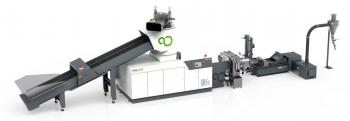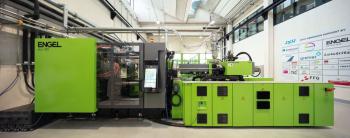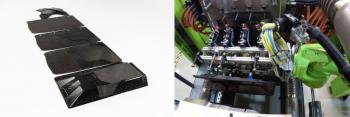Technical Report 2022-03-02
Content shown in the technical articles are the sole opinion and views of the authors or companies, which are not necessarily congruent to opinion and views of the editors.
|
Use of regranulate from thermoplastic sheet offcuts in injection moulding DI Gerhard Bäck, DI Dr. Klaus Fellner, DI Florian Gruber BSc, Dr.-Ing. Norbert Müller, ENGEL Austria GmbH Thermoplastic composites are paving the way for lightweight automotive design into the circular economy and are therefore very popular with design engineers. With component quantities in the high six-digit range per year, the processing of organic sheets is currently the most important thermoplastic composite technology. One focus of further development is the recycling of production waste such as offcut residues. ENGEL has been able to demonstrate that regranulates made from thermoplastic sheet offcuts can be processed in injection moulding while retaining their material properties. This makes it possible to keep the composite raw materials completely in the cycle. Thermoplastic sheets are fibre-matrix preforms that are mostly offered as sheets. They consist of continuous fibres embedded in a thermoplastic matrix. This thermoplasticonly approach allows for the efficient integration of the forming and functionalisation of the blanks, which in turn reduces unit costs and makes the technology attractive to the automotive industry. During processing, the thermoplastic sheets are heated, formed directly in the injection mould and then immediately provided with the desired detailed geometries by injection moulding. As a rule, materials from the matrix material group of the thermoplastic sheet are used for injection moulding. The intent is to use regenerated materials from offcut residues of thermoplastic sheets in the future. This would make it possible to produce components which consist entirely of a single fibre-reinforced thermoplastics and which could be easily recycled at the end of their service life with a view to the circular economy.
 Bild 1: Für die Versuche wurde aus Organoblech-Verschnittabfällen auf Basis unidirektionaler (UD)-Tapes (links) ein Regranulat (rechts) hergestellt. (Bilder: PURE LOOP) To demonstrate feasibility, injection moulding machine manufacturer ENGEL (Schwertberg, Austria) and PURE LOOP, a company of the EREMA Group based in Ansfelden, Austria, which specialises in plastics recycling, have conducted a series of tests to investigate the processing of thermoplastic sheet offcuts and downstream processing of the regenerate in a manner appropriate to the material. Keeping the length of the glass fibres  Bild 2: Das für die Versuche eingesetzte Composite-Material wurde von Profol in Deutschland aus Glasfasern und Polypropylen produziert. (Bild: Profol) In addition to stiffness, the key factor in lightweight engineering applications is the high mechanical load-bearing capacity of the material, which can only be ensured if the length of the fibres is maintained and the fibres are evenly distributed in the matrix. Traditionally, long glass fibre reinforced materials result in materials with shorter fibres when reprocessed. The challenge in recycling the continuous fibre-reinforced thermoplastic sheet preforms was therefore to establish a preparation and processing method in injection moulding that ensures the retention of the greatest possible fibre lengths. For the tests, ENGEL used Progano brand thermoplastic sheets by Profol (Halfing, Germany), which are made up of UD tapes with 72 wt.% glass fibres in a polypropylene matrix (picture 2). Customer-specific cutting results in offcuts. An ISEC evo 302 production unit by PURE LOOP was used to regranulate the offcut waste (picture 3). The special feature of this production unit is that the shredder and extruder screw are mounted on a shared shaft. The infeed material was thermoplastic sheet strips with a length of approx. 1.5 metres. The aim was to reduce the fibre content to 40% by weight. The offcut material was fed to the production unit with the help of a conveyor belt. It then drops into a hopper, at the lower end of which the shaft begins. The cutting elements are located in this area of the shaft. The shredded material passes through a compactor section to an iris valve that controls the material flow. Unreinforced PP is fed in pellet form and the material mixture is plasticised. Not using a filter in the extrusion section was a deliberate decision; this would remove the long fibres. Finally, the material was hot pelletised off and dried in a centrifuge.  Bild 3: Für die Regranulierung der Beschnittabfälle kam eine ISEC evo 302 Anlage von PURE LOOP zum Einsatz. Schredder und Extruderschnecke sitzen bei diesem Anlagentyp auf einer gemeinsamen Welle. (Bild: PURE LOOP) This successful recycling of production waste shows the potential for automotive components at the end of the vehicle's service life. After cleaning the components and removing any metal inserts used, they can be recycled into regranulate in the same way. No difference to virgin material in injection moulding Subsequently, injection moulding tests were carried out on the regranulate obtained in order to assess both the processability and the component quality to be achieved. In ENGEL's technology centre at the company's headquarters in Schwertberg, sample parts were produced on an e-victory 1640/300 injection moulding machine, a production unit that is predestined for the production of medium-sized thermoplastic sheet components. Due to its tie-bar-less clamping unit, the e-victory hybrid machine with electric injection unit enables fast hot handling, which is crucial for the feasibility of the process when manufacturing products with thin thermoplastic sheet.  Bild 4: An der LIT Factory in Linz, Österreich, wurden in einem integrierten Prozess seriennahe Musterteile produziert. (Bild: ENGEL) The regranulate was premixed in a masterbatch mixer on a trial basis in order to simulate the influence of an optional homogenisation step – for example in a silo by means of an agitator. Weighing the components showed slightly higher standard deviations for the regranulate compared to the virgin material. In absolute terms, however, the standard deviations were very small for both materials. With a target shot weight of 400 grams, the standard deviation when processing the regranulate was in the region of 0.7 grams, while it was about 0.15 grams when processing the virgin material.  Bild 5: Die sehr gute Qualität der produzierten Musterteile und die hohe Effizienz des integrierten Verarbeitungsprozesses zeigen das große Potenzial der Aufbereitung von Organoblechverschnittabfällen auf. (Bilder: ENGEL) Sights set on automotive high-volume production LIT Factory After the successful regranulation and injection moulding tests using tape-thermoplastic sheets, the question arose as to their transferability to real components. ENGEL and PURE LOOP collaborated with LIT Factory in Linz, Austria, to produce sample parts with near-series maturity in an integrated process (picture 4). The continuous fibre-reinforced thermoplastic sheets were cut to size and fed to the handling robot via magazines. They were heated in the integrated IR oven, inserted by the articulated robot into the mould of the ENGEL duo 350 injection moulding machine, formed there and overmoulded with offcut waste regranulate (picture 5 and lead image). The very good component quality achieved and the high efficiency of the integrated manufacturing process demonstrate the huge potential of processing thermoplastic sheet offcut waste for series production applications in lightweight automotive engineering. ENGEL and PURE LOOP are continuing to work together to leverage this potential.The LIT Factory at the Johannes Kepler University's Linz Institute of Technology (LIT) is a networked teaching, learning and research factory. With a focus on digitalisation and connectivity in production processes, lightweight engineering technologies are developed and optimised along the entire value chain – from product development and processing to recycling with a view to a circular economy. EREMA and ENGEL are founding members and partners of LIT Factory. References Müller, N., Zwicklhuber, P.: "Blick fürs Essenzielle" (An Eye for the Essential), Kunststoffe 8/2020, p. 26-29 ENGEL Austria GmbH Ludwig-Engel-Straße 1 Phone: +43(0)50 620-0 Internet: www.engel.at |
 back to the list back to the list |  back to top back to top |



